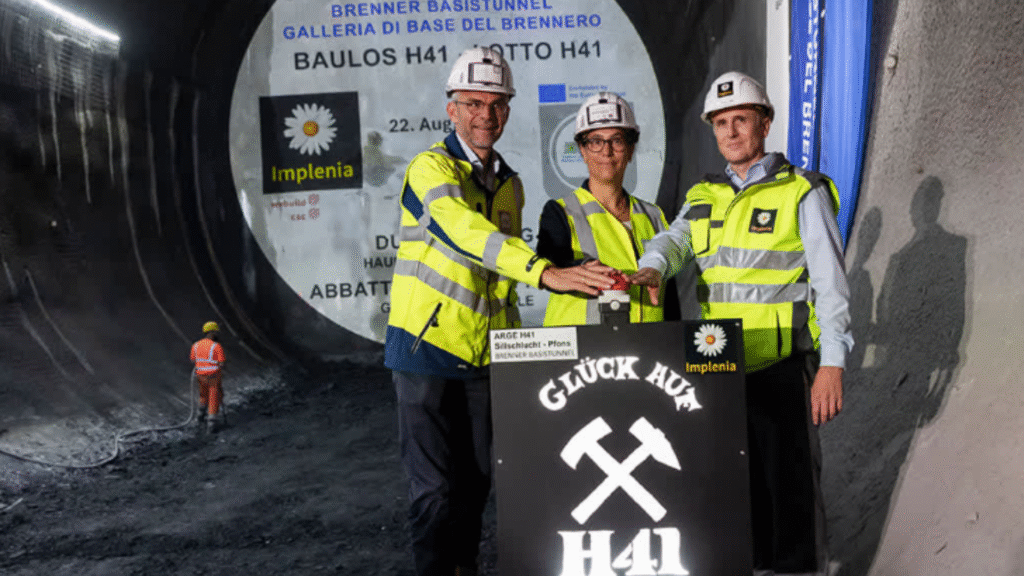
Workers on Thursday achieved a historic breakthrough beneath the Austrian Alps, piercing the final wall of rock to complete the exploratory drives of the Brenner Base Tunnel. At 1,400 meters below the Brenner Pass, Italian Premier Giorgia Meloni and Austrian Chancellor Christian Stocker led a ceremony marking the event, which opens the first direct rail tunnel linking Italy and Austria. When completed, the 55-kilometer underground passage will be the world’s longest railway tunnel, dramatically transforming passenger and freight transit across Europe’s Alpine spine.
Historic Breakthrough and European Rail Transformation
The Brenner Base Tunnel excavation commenced in December 2007, with crews boring from both the Austrian and Italian portals toward the geometric center beneath the pass. Thursday’s breakthrough finalizes the exploratory bores, affirming the project’s engineering prowess despite complex geology, extreme temperatures, and high groundwater pressures. According to the European Commission, the tunnel is a cornerstone of the Scandinavian–Mediterranean Corridor, an EU priority corridor that will ultimately link Helsinki to Palermo via high-capacity, low-emission rail.
Once operational in 2032, the tunnel will reduce travel times between Fortezza (Italy) and Innsbruck (Austria) from the current 80 minutes to approximately 25 minutes, offering competitive alternatives to short-haul air travel and cross-Alpine highways. The breakthrough also anchors a suite of four major Italian infrastructure initiatives slated for completion by the early 2030s, collectively reshaping the European transit map. These projects include:
- The Genoa–Tortona high-speed rail line, featuring 37 kilometers of new tunnels to halve travel time between Milan and Genoa to about one hour.
- The Lyon–Turin High-Speed Rail Tunnel, which will carry passenger trains between Paris and Milan in 4½ hours, down from 6½–7½ hours at present.
- The proposed Strait of Messina Bridge, budgeted at €13.5 billion, set to link mainland Italy with Sicily by road and rail for the first time.
Together, these developments represent a pan-European push to shift both passenger and freight transport onto sustainable rail corridors, reducing greenhouse gas emissions and strengthening economic integration across member states (WFTV).
Freight Capacity and Environmental Impact
The Brenner Pass currently handles over 2.5 million heavy trucks annually, ranking it among Europe’s busiest and most congested Alpine corridors. The Base Tunnel is designed to reroute up to 50% of road freight onto electric rail, addressing critical environmental and public-health challenges. European Commissioner Apostolos Tzitzikostas stated at the ceremony that diverting trucks will “improve air quality, diminish noise pollution, and reduce CO₂ emissions” in fragile Alpine ecosystems and densely populated valleys.
Moreover, Italy’s broader rail modernization program—bolstered by €25 billion in EU pandemic-recovery funds—includes 40 additional strategic rail projects. These range from high-speed links between Naples and Bari to upgraded freight terminals in Trieste and Venice, facilitating seamless transfers between maritime ports and Europe’s heartland rail network. Together, these initiatives underscore the European Green Deal’s objectives to decarbonize transport and promote modal shifts from road to rail.
Project Timeline, Cost, and Challenges
The Brenner Base Tunnel project has faced significant delays and cost overruns. Originally slated for completion in 2016, the tunnel is now expected to open in 2032, 16 years behind schedule. The budget has ballooned from an initial estimate of €6.3 billion to roughly €8.8 billion, reflecting unforeseen geological hurdles, inflationary pressures, and the complexity of cross-border governance.
Despite these setbacks, Premier Giorgia Meloni characterized the breakthrough as evidence that “there is no project too big to be tackled.” She praised the collaboration between Italian and Austrian engineers and the European institutions that provided €3.3 billion of funding, noting that the tunnel’s long-term economic and environmental benefits will far outweigh its near-term costs.
Strategic and Economic Implications
The completion of the exploratory bores positions the Brenner Base Tunnel as a strategic linchpin in Europe’s low-carbon transport network. By providing rapid, high-capacity rail links across national borders, the tunnel will facilitate the movement of millions of passengers annually and carry up to 30 million tons of freight per year. This modal shift is expected to relieve pressure on congested roads, lower freight costs by as much as 20%, and enhance supply-chain resilience for industries ranging from automotive manufacturing to agricultural exports.
Furthermore, the tunnel’s success paves the way for deeper economic integration within the Alpine region, promoting cross-border labor mobility and tourism. Innsbruck and Bolzano–Bozen are poised to emerge as key rail hubs, connecting northern European markets with Mediterranean ports. The Brenner Base Tunnel thus symbolizes not only human ingenuity in overcoming natural barriers but also a shared European commitment to sustainable, future-oriented infrastructure.
As tunneling machines are dismantled and final lining works commence, Europe watches the Brenner breakthrough as a harbinger of a new era—one in which the Alps no longer divide but unite the continent under a web of green, high-speed rail arteries.












